Welcome to Chengdu, the capital of Sichuan, which is known for its famed hotpot and culture. In this guide, you will find helpful tips for Chengdu. Within three days, you will have the opportunity to explore fully everything Chengdu has to offer. Your trip will include visits to restaurants serving the popular torn-boiled fish and Chongqing Hotpot, sightseeing at gorgeous locations and parks around the city, and even paying a visit to the Chengdu Research Base of Giant Panda Breeding, which has some of the best-rated and most famous landmarks in the city. This itinerary is perfect for any traveler, whether you love history and food or want to explore a new city. You will indeed have a fantastic time and a memorable vacation in Chengdu.
What to See in Chengdu During Your 3 Days Visit?
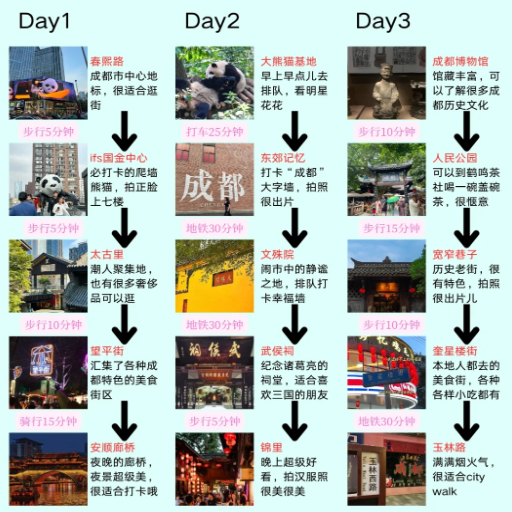
What to See in Chengdu During Your 3 Days Visit
Day 1: Dive into Chengdu and Its Landmarks
One of the must-see attractions is the Chengdu Research Base of Giant Panda Breeding, where you can see pandas at the Chengdu Zoo. Walk in the Chengdu Wide and Narrow Alleys, a historical area filled with Sichuan-style architecture, boutique shops, and cafes. Finally, your day should end at Jinli Ancient Street, where the lively ambiance and the local street food are delicious.
Day 2: Explore Chengdu through food and culture.
The cultural site Wuhou Shrine, dedicated to the famous strategist Zhuge Liang, is a good place to start understanding Chengdu’s culture. After that, you can focus on a true gem called Du Fu Thatched Cottage. He is among the most loved poets in China. Sze Chuan hotpot is a local delicacy perfect for spicy food enthusiasts.
Day 3: Relaxing and nature walk
Refresh yourself at Mount Qingcheng, a UNESCO World Heritage Site famous for its Taoist temples and natural green surroundings. A cable car can be used in the morning for vertical hiking and scenic views. On the way back, see the ancient engineering wonder dujiangyan irrigation system, which is still used today. Have some of Chengdu’s tea while relaxing in one of the quaint tea houses to end your trip.
Top Attractions in Chengdu
- Pandas at Chengdu Research Base of Giant Panda Breeding
The Chengdu Research Center of Breeding Giant Pandas Base is a renowned facility and one of the most famous attractions in this region. Pandas of all ages are allowed to be seen by tourists in locations that look like their natural habitats.
- Hours: 7:30 AM – 6 PM
- Best Time to Visit: Morning (when pandas are most active)
- Recommended Duration: 2–3 hours
- Jinli Ancient Street
Jin Li Ancient Block is famous for its shopping and local culinary delicacies. Visitors can find local snacks and arts and crafts and enjoy street performances, enhanced by the sight of magnificent lanterns hanging around the place.
- Hours: Open 24/7 (shops primarily operate from 10 AM – 10 PM)
- Highlights: Street food, Sichuan opera performances
- Wuhou Shrine (Wuhou Temple)
Visitors can learn about the history of Zhuge Ling, a remarkable character of Chinese history through the Three Kingdoms period, as they visit this temple. The site’s beautiful gardens offer a calm and peaceful experience.
- Hours: 8 AM – 6 PM
- Key Features: Ancient relics, statues, calligraphy
- People’s Park
The park is the heart of Chengdu City and exemplifies the relaxed atmosphere that residents experience. The park also offers aerobic dancing, tea drinking on site, and the beauty of gardens and koi ponds.
- Hours: 6 AM – 10 PM
- Popular Spot: Heming Teahouse
- Sichuan Opera and Face-Changing Performance
Explore the captivating Sri Chuan Opera with the astonishing face-changing act. These performances represent the ancient culture of the area.
- Locations: Shufeng Yayun Teahouse, Jinjiang Theater
- Duration: Typically 1–1.5 hours
Chengdu is captivating because of its harmony of culture, history, and nature, and it is a place worth every inch of exploration.
Best Time to Visit Chengdu
Spring (March to June) and autumn (September to November) are the most favorable times to visit Chengdu. During these periods, the region experiences mild temperatures, low precipitation, and a decent overall climate, making it suitable for outdoor activities and sightseeing.
- Spring (March to June)
In Spring, flowers blossom, and temperatures are pleasantly warm, ranging from 50 to 75 degrees Fahrenheit (10°C to 24°C). This is a good time to visit places like the Chengdu Research Base of Giant Panda Breeding and the beautiful Countryside of Chengdu.
- Autumn (September to November)
Autumn is notable for its strong visibility, clear blue skies, and calm winds. It is equally beautiful, with temperatures between 54 and 77 degrees Fahrenheit (12°C to 25°C).
Must-See Sights on Day 1 in Chengdu
Day one in Chengdu should start at the Chengdu Research Base of Giant Panda Breeding, roughly 10 kilometers from the city center. The giant pandas are most active when fed in the morning from 830-1000 hours. Don’t skip the bamboo forest and on-site museum, which have great information on the conservation of giant pandas.
After this, I would recommend Wenshu Monastery, one of the city’s most important historical Buddhist temples. Its outstanding features are its architecture, peaceful environment, and authentic local tea in the tea house.
To conclude the day, I recommend Jinli Ancient Street. This street is full of life and is a pedestrian zone. Here, you can see traditional Sichuanese-style buildings, buy local snacks and souvenirs, and enjoy cultural performances. The street gets even more lively in the evening and is beautifully lit, making it an excellent location for dinner and entertainment.
How to Plan Your Chengdu Itinerary for 3 Days?
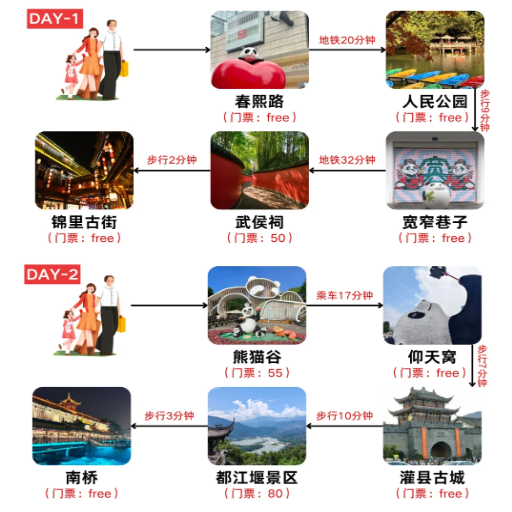
How to Plan Your Chengdu Itinerary for 3 Days
Day 1: Tour Chengdu’s Cultural Heart
Start your trip with a visit to Konglin’s Love Cafe, where you will fall in love with tea; this is an excellent place for relaxation and cultural immersion. The next stop is Ancient Jinli Street, where food, crafts, and talents put on a great show for you. Before heading to sleep, stroll in People’s Park and old Chengdu. Jiuzhaigou. Grab a seat at the head of the tea house, sip the locally made tea, and let your eyes wander through the cultural spectacle around you.
Day 2: New Discoveries Spirit
Mawnongfutou, located next to the Wuhou Shrine, dominates a valley filled with ancient characters from China’s three empires. Afterward, head to the Chinese Qing Yang Taoist Temple, famous for its exotic architecture. Feel free to enjoy a quiet, relaxing ambiance at Du Fu Thatched Cottage, famed for housing one of China’s greatest poets. You are free to explore Dufu’s town for the rest of the evening.
Day 3: Move on the Scenic Mount Qingcheng
The short ride outside the city to Mount Qingcheng is hugely pleasurable. Its breathtaking views alone make Qing Cheng a UNESCO World Heritage Site. After enjoying the stunning sunset over the mountain, stop by the ancient engineering marvel of Dujiangyan Irrigation System. Always leave a few minutes of your day (after dinner) to sit down by the main street. The perfect way to round up your day is the famed Sichuan hotpot, so don’t miss out on it before heading to bed.
Starting Your Chengdu Tour
Before commencing your journey in Chengdu, significant preparational efforts are required to ensure a seamless and enjoyable experience. Here’s how to get started:
- Best Time to Visit:
Chengdu features mild weather all year. Still, the ideal months are between March and June and September and November, when the temperature averages around 15-25ºC, making outdoor activities delightful.
- Transportation:
- By Air: Deepen your experience by arriving at the Chengdu Tianfu International Airport or the Shuangliu International Airport. Both are well-equipped and have a lot of traffic.
- Local Transport: Chengdu also uses a metro system, which helps improve efficiency when traveling in the urban regions. You could also use shared bikes, readily available all over the city. Taxis and rideshare apps like DiDi also provide convenience.
- Accommodations:
Generally, your stay should be determined by distances to sites of interest. The best areas are Kuanzhai Alley if you are looking for history and Chunxi Road if you prefer modern amenities. Mid-range hotels typically cost $50–$80 per night, while budget options are also available and range from $120 upwards.
- Essentials to Pack:
- Comfortable walking shoes for exploration.
- Light rain gear, as Chengdu is known for occasional drizzle.
- A power adapter for Type I plugs, commonly used in China, with a standard voltage of 220V.
Follow these simple steps to systematically prepare to enjoy the city’s captivating beauty while making the most of your time.
Exploring Chengdu City on Day 2
On Day 2, explore Chengdu by visiting Kuanzhai Alley (Wide and Narrow Alleys). This historical site features shops and teahouses and preserves architecture from the Qing Dynasty. Spend the morning walking around the alleys and taste local treats like dan noodles or boboji skewers.
Next, travel to Wuhou Shrine, a historically significant location for Zhuge Liang, a renowned strategist during the Three Kingdoms period. This shrine presents the tranquil surroundings of gardens and gives a citadel feel. The admission fee ranges from around ¥50 to USD 7.
For lunch, go to the busy shopping Chunxi Road: Chengdu. Here, you can enjoy authentic Sichuan cuisine with the best Mala hotpot. Many restaurants have English menus, so it is easy for visitors.
To conclude the afternoon, visit People’s Park, a central meeting point for relaxation and social interactions. Enjoy a cup of tea from an open-air teahouse, take a boat trip around the lake, or watch unusual ear-cleaning activities.
Conclude your day with the Sichuan Opera’s extraordinary show at the Shufeng Yayun Teahouse. The Tear House is popular for its “Face-Changing” act, highlighting quick costume and mask changes. Evening shows often start at 8 PM, and prices range from ¥120–¥200 ($16–USD 28) depending on seating.
This itinerary allows you to appreciate Chengdu’s cultural and culinary beauty. Capture all these wonderful moments with your camera, and make sure your battery is fully charged.
Wrapping Up with Day 3 Highlights
Day Three in Chengdu was astonishing. To start my day, I went to the Leshan Giant Buddha, a work of art. This 71 m towering statue is recognized as a UNESCO World Heritage Site and is over two hundred feet tall. Carved out of Sandstone cliffs, the Giant Buddha statue is a beauty to behold and lacks details, with its history tightly intertwined. Afterward, I visited one of the fantastic museums, the Jinsha Site Museum. The famous golden sun bird disk, alongside many other Golden Era treasures, amazed me and provided a great insight into China’s ancient Bronze Age. Following this, when evening came, I was enchanted by the beautiful and mystifying Shufeng Yayun Teahouse. The most memorable part of his performance was the mesmerizing art of ‘Face Changing’ Sichuan Opera. I made this visit and was not disappointed; the incredible Jiasha site museum is well maintained and reasonably priced, ranging from ¥100 to ¥200 ($14–$28). Be sure to set enough time aside for all your stops to contemplate everything truly.
Where to Experience the Pandas in Chengdu?
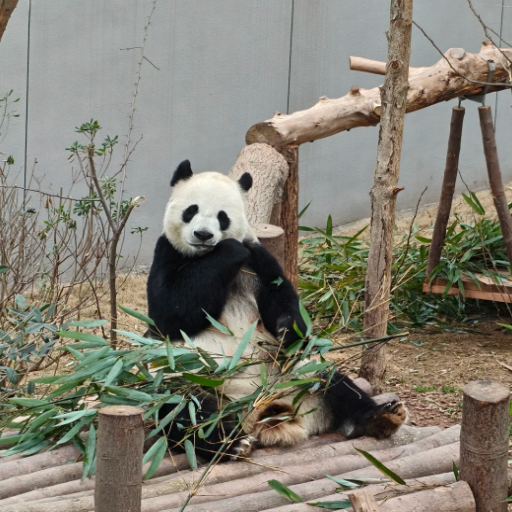
Where to Experience the Pandas in Chengdu
Perhaps one of the most alluring places to see pandas in Chengdu is the Chengdu Research Base of Giant Panda Breeding, 10 kilometers or 6 miles from the city center. This facility is famous for its work in conservation and research and provides visitors a chance to see these lovely creatures up close and in a quasi-natural setting. To maximize your visit, arrive early in the morning to see feeding times when the pandas are most lively. Another good choice would be the Dujiangyan Panda Base, approximately an hour’s drive from Chengdu, where you can even volunteer to help learn how to care for pandas and conservation activities.
Visit the Chengdu Research Base of Giant Panda
1. What are the opening hours of the Chengdu Research Base of Giant Panda?
The base is open every day from 07:30 to 18:00, with the last entry at 17:00. The best time to visit is in the morning because you can spot the pandas during their most ‘active’ hours, which is eating. The most popular slots for mid-morning feedings are from 8:30 to 10:00.
2. How much is the entrance fee?
The estimated cost of the Panda entrance fee is around 55 CNY for adults. Children’s, senior, and student fares exist but are subject to change. Always check the current prices on the official website before traveling.
3. Are guided tours available?
Yes, guided tours are available at an extra cost. These provide more detailed information about panda conservation work, research activities, and the pandas’ environment.
4. What facilities are available on-site?
The research base has visitor facilities such as restrooms, sitting areas, cafes, and a gift shop. Visitors are also supplied with maps and signposts on the site to help them locate different areas of the facility.
5. How do I get to the base?
It is approximately 10 kilometers (6 miles) from the Chengdu city center. Clients can use taxis or ride-sharing cars. Public transportation also has routes to the base, namely bus #198 and #198A. The journey usually lasts between 30 and 45 minutes, depending on the traffic.
6. Can I take photos with pandas?
Visitors are not allowed to contact pandas directly and take pictures with them as this is highly regulated for their safety. Certain programs may offer this opportunity under strict guidelines and additional fees, so it is essential to stay updated.
7. Is there a best time of year to visit?
Pandas can be seen anytime during the year, but spring and autumn are great for a pleasant visit. Eighter way, mornings are usually best for visiting during any season.
For further information, visit the Chengdu Research Base of Giant Pandas’s official website or contact visitor services.
Understanding the Base of Giant Panda Breeding Program
The Chengdu Research Base aims to breed giant pandas in captivity to conserve their habitat while educating the public about the species. The technologically advanced facility is designed to closely resemble the species’ natural environment so the pandas are nurtured and encouraged to breed naturally. The program aims to combine research, education, and breeding to ensure that the giant panda species survive in captivity and by controlled release into the wilderness.
Remember these details, which show the importance of the program’s dedication to panda conservation efforts:
- Temperature Control: Panda enclosures have a humane ventilation AC system that keeps the temperature at a consistent 18°C–24°C (64°F–75°F) to promote the animals’ overall health.
- Feeding Practices: Pandas are fed worldwide, each requiring 20–40 pounds of bamboo daily. Their diet must include fruits, vegetables, and delicious panda cakes to balance energy and nutrients.
- Reproductive Efforts: Hormonal and ultrasound monitoring allows for improved artificial insemination success rates. This ensures more proper breeding conditions and enhances the chances of survival among newborn cubs.
- Panda Releases: The program uses a “soft-release” technique, in which the pandas are first trained to survive in the semi-wild and then released into the wilderness.
This program is renowned worldwide for its excellence in conserving giant pandas. It employs cutting-edge approaches while encouraging international collaborations to ensure these magnificent animals persist for future generations. In addition, always check the Chengdu Giant Panda Base’s official website for other news and information.
Tips for Seeing the Giant Pandas Up Close
I suggest visiting well-known panda conservation centers such as the Chengdu Research Base of Giant Panda Breeding to get up-close views of Giant Pandas. I recommend scheduling your visit early in the morning as this time tends to be the most active. Additionally, schedules between 8 and 10 are optimal as this is when they are being fed. If you plan on visiting during spring or autumn, the experience is improved since pandas tend to be more playful in cooler conditions.
Book tickets beforehand because the few centers that allow entry almost always sell out, and booking online increases your chances of gaining entry. Several centers have guided tours that educate visitors about pandas’ behavior and conservation efforts. If you wish to get more hands-on experience, some centers that allow feeding tours might have a nursery area. (Availability often differs and will most likely have extra charges.)
Use a camera with a zoom lens (70-200mm) to ensure you do not disturb the animals and follow the staff’s guidelines. To maintain your and their safety, it’s best to remain silent without feeding or touching the pandas.
What Are the Culinary Delights of Chengdu?
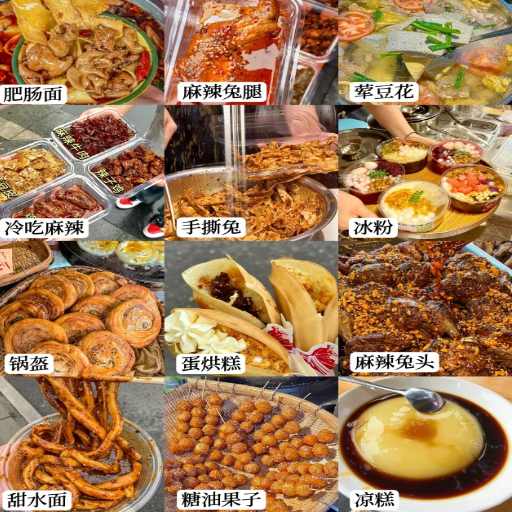
What Are the Culinary Delights of Chengdu
Chengdu, the capital of Sichuan Province, is known throughout the globe for its unique and prominent cuisine. The Sichuan peppercorn is at the heart of its culinary culture and is famed for its numbing and spicy sensation in many dishes. Chengdu’s famous Mapo Tofu, a pungent, saucy concoction of minced meat, tofu, and hot spices, is a must-try with Kung Pao Chicken that bursts with tangy and savory goodness. Chengdu is also the home of the famous Sichuan Hot Pot, which allows customers to dip meats, vegetables, and even tofu into broth, bubbling hot and seasoned with pungent spices. Street food lovers will delight in Dan Dan Noodles, Chuan Chuan (skewers), and the local delicacy Rabbit Head. Chengdu’s culinary landscape is an unforgettable adventure, whether a hot pot feast with friends or munching seasoned street food.
Indulging in Sichuan Cuisine
One can look into Sichuan cuisine and its superb profile and different compounds that make it exquisite in terms of taste and spice:
- Core Ingredients:
- Sichuan Peppercorn: Delivers the signature numbing sensation (má là).
- Chili Peppers: Provide layers of heat essential to the cuisine.
- Doubanjiang (Fermented Broad Bean Paste): Offers a rich, savory depth to dishes.
- Garlic and Ginger: Frequently used to enhance the aromatic base.
- Soy Sauce and Vinegar: Add balance with umami and tangy notes.
- Flavor Profiles:
- Sichuan cuisine is famous for combining bold elements such as sweet, sour, spicy, salty, bitter, aromatic, and numbing tastes.
- Some of the combinations would be “you Xiang,” which means fish fragrant, “guai wei,” known as a strange flavor, and “ma la,” for numbing spice, which indicates its versatility.
- Cooking Techniques:
- Stir-frying (e.g., Kung Pao Chicken): Quick and high-heat method to lock in flavors.
- Braising (e.g., Mapo Tofu) accentuates the richness while deep spices control the blend.
- Boiling (e.g., Sichuan Hot Pot) engulfs the food with an even blend of bold, spicy taste.
- Key Aspects:
- Spice to protein levels, such as two tablespoons of chili oil with two hundred grams of protein.
- Cook levels like stir fry allow for simmering at a high temperature of 425 F 218 C or give hot pot broth an even blend of 120 F 49 C to 140 F 60 C.
- Timing to keep textures, stir for three to five minutes and Braise for fifteen to thirty minutes.
Whether used to prepare delicate or fiery stews and snacks, these ingredients, flavors, and techniques enable a truly authentic dining experience in Sichuan.
Where to Find the Best Hot Pot?
Sichuan cuisine is known for its hot and spicy flavor, which is why hot pot is their specialty. Luckily for food lovers worldwide, Sichuan’s hot pot can be savored in many well-known restaurants. Some of them are:
- Haidilao Hot Pot (Various International Locations)
People are amazed by the service provided at Haidilao. In addition to spicy Sichuan broth, customers can choose their broth, which makes the experience even better. At Haidilao, the broth is rich in flavor and heat, cooked at 280° —300° F. Customers can also grab their signature spicy dipping sauce made from chili oil and garlic.
- Shu Jiu Xiang Hot Pot (Chengdu, China)
Due to its location in the very core of Sichuan province, Shu Jiu Xiang is famous for delicious traditional recipes. The traditional Golder Standard spice-to-broth ratio utilizes 100 g of Sichuan peppercorns for every liter of base broth. The result? A hot pot requires an undeniably spicy and numbing sensation.
- Little Sheep Mongolian Hot Pot (North America & Asia)
People love Little Sheep’s hotpot because it differs from the traditional spicy Sichuan style. While slightly less pungent than other hot pots, Little Sheep’s signature broth offers rich herbal flavors and a blend of spices perfect for cold weather. Their broth is also cooked with herbs and spices but at a lower temperature of 200° – 210° F.
These places are acclaimed hot pot places that require high-quality ingredients and exquisite cooking skills. For those who appreciate the flavors of Sichuan food, these places are some of the finest restaurants that effortlessly prepare this classic dish.
Exploring Local Tea Houses and Sichuan Opera
A holistic cultural tour of Sichuan is incomplete without visits to local tea houses. These tea houses serve as excellent social facilities, so why not enjoy famous teas such as jasmine, green, or oolong? These spices are best enjoyed at the ideal temperatures of 175-185 degrees Fahrenheit (80-85 degrees Celsius) for green teas or up to 200 degrees Fahrenheit (93 degrees Celsius) for the darker teas. The attention paid to even the brewing process ensures the finest taste. Likewise, even a Sichuan Opera is a delight to watch due to the famous face-changing (Bian Lian) performance art that has become synonymous with the region, all while listening to traditional music and watching dancers in beautiful costumes. Both performances breathtakingly showcase the culture of Sichuan, evoking all five senses and telling age-old stories in one form or another, making these performances so immense.
What Day Trips Can You Take Around Chengdu?
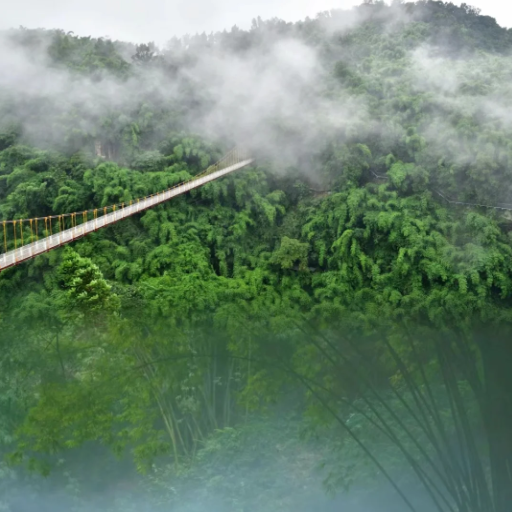
What Day Trips Can You Take Around Chengdu
Chengdu entertains its visitors with its beautiful day trip options, such as outdoor activities, rich history, and sometimes even culture. Nature lovers can visit the Giant Panda Breeding Research Base, which offers animal viewing in a more appealing setting than a plain zoo. It is a must for wildlife lovers. Suppose your interests gravitate more toward historical places. In that case, the Dujiangyan Irrigation System, a UNESCO World Heritage site, is perfect for you since it features breathtaking scenery plus ancient engineering wonders. Mount Qingcheng gives hikers tranquil temples and green hiking paths and is known as the birthplace of Taoism for all nature lovers. It is also home to the Leshan Giant Buddha, standing tall as the world’s most prominent stone-carved figure bone of spiritual and architectural wonders. These destinations are conveniently well-connected to Chengdu, making them well-balanced for perfect Day Trips.
Visiting the Leshan Giant Buddha
For those venturing outside Chengdu, the Leshan Giant Buddha is one site that checks all the boxes. This enormous statue is located at the confluence of the Dadu, Min, and Qingyi rivers, and it is the largest stone-carved statue of a Buddha ever to exist, standing at an impressive 71 meters (233 feet). Born out of the Tang Dynasty’s cliff carving techniques, this statue is profound in historical and religious contexts. People can appreciate the statue’s impressive size and fine details that capture the Buddha’s calm demeanor.
Key Information:
- Height: 71 meters (233 feet)
- Shoulder Width: 28 meters (92 feet)
- Ear Length: 7 meters (23 feet)
- Feet Length: 8.5 meters (28 feet), large enough to seat over 100 people.
- Construction Period: Spanning over 90 years, beginning in 713 CE during the Tang Dynasty.
One can access the walking trails surrounding the sculpture or view the statue from the water by taking a riverboat. Climbing footwear and a camera are suggested when visiting this site, as it is best to see in the mornings or late afternoons to get the best shots. Whether you are interested in learning about ancient cultures and religions or want to see stunning architecture, the Leshan Giant Buddha offers it all and should be added to your hashtag list.
Exploring Mount Emei – A UNESCO World Heritage Site
Mount Emei is located in Sichuan Province, China. It is one of the Four Sacred Buddhist Mountains and a UNESCO World Heritage Site. This place is famous for its rich culture, nature, and religion, so if you enjoy exploring mountains, practicing religion, or observing nature, you will be delighted.
At 3,099 meters (10,167 feet) above sea level, Mount Emei is home to many ecosystems, from subtropical forests to alpine flora and fauna. The region has well-maintained hiking routes, so visitors can appreciate its beauty while encountering rare wildlife, such as the local Emei Shan Liocichla.
Key Highlights and Features:
- The Golden Summit (Jinding): At an elevation of 3,077 meters (10,095 feet), this summit offers rare and beautiful views of sunrise, the ‘Sea of Clouds,’ and Buddha’s Light.
- Buddhist Temples: More than thirty temples have been built around the mountain, the most famous of which are the Wannian and Baoguo Temples. The temples, dating back to the Han Dynasty, have a rich history and complex carvings and sculptures.
- Hiking Trails: The mountain provides over 50 kilometers (31 miles) of hiking trails with different difficulty levels. Walkers and even experienced hikers can enjoy the trails. Cable cars are also available for people who wish to have a casual approach.
Tips for Visiting:
- Best Time to Visit: The spring season, from April to June, and the Autumn season, from September to November, offer pleasant weather and great views. Crowds are also less during these times.
- Proper Gear: Wear sturdy and durable shoes due to steep paths, and ensure that you always wear layered clothing due to the ever-changing weather.
- Entrance Fees:
- Main Entry Ticket: ~CNY 160
- Golden Summit Cable Car (Single Trip): ~CNY 65 (lower section) + CNY 55 (upper section).
Whether visitors come for the scenery, spiritual calmness, or strenuous hiking, Mount Emei never fails to impress with its rich history and breathtaking nature. Visitors always leave with memorable experiences.
A Trip to the Historical Wuhou Shrine
Seeing and walking around at the Wuhou Shrine was fascinating and provided an understanding of the Three Kingdoms period. Chengdu is home to a shrine for a well-remembered military general, Zhuge Liang, and his life. The gardens, sculptures, and classical buildings are beautiful, adding to the solemn atmosphere which promotes introspection. It only costs about CNY 50, which is very reasonable for a place that adds value to people. It is best to visit in the morning to avoid the heavy crowds, and there is more than enough time to see the Liu Bei Temple, the main hall, and all the other highlights on offer. To walk around the extensive grounds, sensible shoes should be worn. The Wuhou Shrine, as a case study, gives insight not only into the history of China but also provides a peaceful retreat from city life, thus making it valuable to serious historians and ordinary tourists.
References
Frequently Asked Questions (FAQ)
Q: How many days should I spend in Chengdu?
A: Spending 3 days in Chengdu is ideal to fully enjoy the city’s main attractions, such as the Chengdu Panda Base, Wenshu Monastery, and a food tour. It gives you ample time to see the pandas, explore the local culture, and enjoy leisurely activities.
Q: What should I do on my first day in Chengdu?
A: Start your day with a visit to the Chengdu Panda Base to see the adorable giant pandas. In the afternoon, explore the bustling downtown Chengdu area and enjoy a traditional Sichuan hotpot dinner in the evening.
Q: What are the must-see attractions for a 3-day Chengdu itinerary?
A: Key highlights for a 3-day Chengdu trip include visiting the Du Fu Thatched Cottage, Chengdu Museum, Wuhou Shrine dedicated to Zhuge Liang, and Jinli Old Street. Don’t miss a tai chi session in one of the city’s parks.
Q: Is a food tour recommended during my Chengdu travel?
A: Absolutely! A food tour is highly recommended to experience Chengdu’s vibrant culinary scene. While exploring bustling markets, you’ll taste local specialties like mapo tofu and dan noodles.
Q: How can I include leisure activities in my Chengdu trip?
A: You can enjoy leisurely activities such as a relaxing visit to a tea house, playing mahjong with locals, or taking a cooking class to learn about Sichuan cuisine. These activities allow you to unwind and immerse yourself in the local culture.
Q: Are there any day trips I can take from Chengdu?
A: A popular day trip is to visit the Leshan Giant Buddha, one of the largest stone Buddha statues in the world. It is located about two hours from Chengdu and can be visited as part of a private tour or on your own.
Q: What is the best way to get around Chengdu?
A: Chengdu has an efficient public transportation system, including buses and a metro network. Taxis and ride-sharing services like Didi are also convenient for getting around. If you prefer, you can book a private tour for personalized transportation.
Q: Can I see the pandas during a Chengdu highlights tour?
A: Yes, most highlight tours of Chengdu include visiting the Chengdu Panda Base, where you can see giant pandas in a natural setting. This is often one of the top attractions for visitors.
Q: What is the best time of year for a trip to Chengdu?
A: The best time to visit Chengdu is during the spring (March to June) and autumn (September to November), when the weather is mild and pleasant, ideal for sightseeing and outdoor activities.